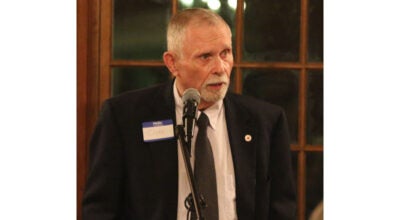Scotland’s stronghold
Published 10:38 am Saturday, January 30, 2016
It sits — brooding — atop a basaltic dome pushed up from the earth’s depths, a conduit for magma venting through an ancient volcano. The volcano has eroded through time, leaving the stone promontory to provide a dominant seat for a castle — Edinburgh Castle, pronounced “edin-boro” by today’s citizens and visitors.
The castle is a symbol of power, almost daring any enemy to try and scale its walls. Some sort of fortification has occupied this location since the 12th century. Habitation by humans is estimated to be from the Iron Age, although much of that history is guesswork. The impermeable rock does not hold remnants of human residence very long. Artifacts from any period are few.
The castle is the main structural symbol of Edinburg, having been used as a royal residence and military stronghold. Today, it’s a military barracks, museum and visitors attraction. It’s on the “must see” list for any visitor.
Protected on the south, west, and north sides by precipitous rock walls, the hill is a defensible bastion, accessible only from the east. Countless sieges, none successful, have been laid over time. Military uses as an armory, weapons foundry and barracks are well recorded. Through time, and many royal family battles for prominence, the structure has been added to and modernized. Each episode leaves its mark on the battlements.
We enter from the south car park area, through minor doors, up an inclined path, through another fortified entryway (Portcullis gate and the Argyll Tower), into a lower courtyard with battlements overlooking the city. The north side is the most likely for troops to be bivouacked for battle. Today, it’s an excellent view of the modern city. This level houses the current police and guards barracks and administration buildings.
Around the corner and up the ramp is the oldest section. Here is the Scottish National War Memorial, with its lone sentry, St Margaret’s Chapel, Royal quarters (yes, still today), water reservoirs and more ramparts. Here Big Meg, a huge mortar, stands guard, overlooking the city to the north. St Margaret’s Chapel, a 12th-century structure, is the oldest surviving building in the castle.
In summer, along the esplanade in the lower court, a pageant takes place. It’s called the Military Tattoo and is a combination of military marching bands and bagpipes, parading and playing to paid audiences. Pageantry at its best. Unfortunately for us, this trip is in spring and we’ll miss it.
We visit and move on to other interests. The castle is connected to another royal residence, Holyrood Palace, by a single road. It’s called the Royal Mile; this is the oldest part of Edinburg. Along either side of this road are shops, Edinburg City government buildings, hotels, and a large assortment of restaurants and living quarters. This is the center of governmental activity — the Scottish Parliament is conveniently located next to the royal palace. Today the palace gates are closed and we can only look through the bars.
A group of school children passes. Their bright, cheerful voices carrying happiness across the day’s coolness. I listen, hearing familiar tones. One young boy says cheerfully to another, “Shut your mouth.” It was spoken, “Shet ye moot.” I listened, surprised by the familiar eastern Virginia inflections. I realized that if you stand in a crowd in Southampton County, close your eyes, and are magically transported to Edinburg, with eyes still closed, the words would be easy to recognize. The “hoose” for house; the “oo” sound in many words. The Gaelic word for motor is modur, with the hard “d.” My brother pronounced it this way all his life. Gaelic “brogans” for large, high top shoes is the familiar “brogans” of eastern Virginia, with equal emphasis on both syllables. The Welsh (or Gaelic) has emphasis on the first.
My wife could not understand any of it. I smiled.
Edinburg has many attractions; we check out Princess Street Gardens. This pleasant section of plantings, walkways and concert stage is built over the main terminal railroad tracks for Edinburg. It’s a far cry from what must have been a smoky, grimy, noisy industrial zone in the past. People peacefully walk and visit along well manicured flower beds and grassy banks.
Every aspect of life in the city is dominated by the outline of the castle on the hill. It is the main tourist destination of all that Edinburg offers. It lives in my memory as just that — a powerful symbol, a message for all to remember. “Whoever lives here is in charge, and will not be conquered easily.”
JAMES D. “ARCHIE” HOWELL is a Southampton County native and 1955 graduate of Franklin High School. He can be reached at archiepix@kingwoodcable.com.





